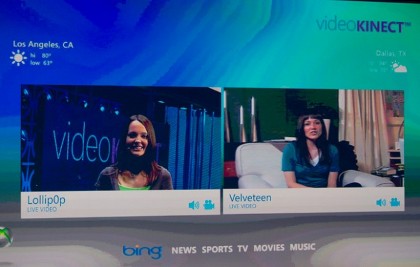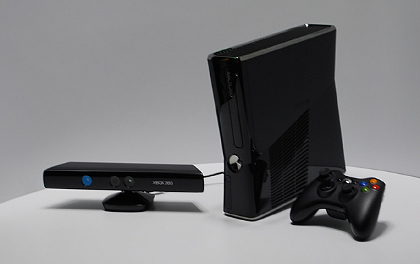And finally, there was the ‘boring’, networks-and-services stuff: a major new deal with ESPN to bring its wealth of sporting events to Xbox Live (demonstrative once again of the length of Microsoft’s bank balance); video chat using the Kinect camera; more cross-over between Windows Live Messanger and XBL. All pretty significant but, from the perspectives of the masses glued to liveblogs and video streams, all definitely secondary to the announcement of new games.

The Kinect camera follows you round the room. Creepy.
It’s worth thinking about that last sentence a little. E3 has always been an enormous hype-sink, but in recent years it has become almost a parody of itself, each publisher trying frenziedly to one-up its rivals in the shock-and-awe stakes. Kinect’s circus act was a case in point, as was Activision’s star-studded blowout a few hours ago. New games are central to this ethos, which is possibly why the guns-and-ammo component of Microsoft’s presser was greeted with such intense ambivalence.
I’d like to propose a more optimistic view of events. For all the weight of expectation that surrounds a manufacturer’s E3 keynote, and for all the talk of Kinect revolutionising the living room, this conference was an exercise not in pioneering new frontiers but in consolidating old ones. Microsoft has acquitted itself admirably in the battle for market share with Sony and Nintendo, and is focussing now on deepening its footholds and shoring up the barriers.
This explains the Xbox 360 Slimline, essentially a glamorous case mod with a few built-in extras, and the preference for proven franchises and already-known projects, with certain promising indie titles (Dust: An Elysian Tale being my hot pick) and Valve’s next big hitter conspicuous by their absence. But most importantly, it also explains the portrayal of Kinect – not as a separate entity, but a well-integrated part of Microsoft’s arsenal, boasting its own subspace within the 360 dashboard, adding another layer of control possibilities to established functionality like movie and music playback.

The future?
Microsoft has reversed Xbox’s fortunes this generation, to a degree only Nintendo can rival. Last night’s show was as much about reflecting on that as it was looking ahead. The only truly critical omission, in my opinion, was a price-point for Kinect – very much the billion dollar question, given the cheapness and prevalence of the hardware the new peripheral intends to compete with.
Was it good for you too, readers? Let us know what you think of Slimline, Kinect and the rest below.





 Satoru Iwata Video Interview - the late Nintendo president spoke with Kikizo in 2004 as 'Nintendo Revolution' loomed.
Satoru Iwata Video Interview - the late Nintendo president spoke with Kikizo in 2004 as 'Nintendo Revolution' loomed. Kaz Hirai Video Interview - the first of Kikizo's interviews with the man who went on to become global head of Sony.
Kaz Hirai Video Interview - the first of Kikizo's interviews with the man who went on to become global head of Sony. Ed Fries Video Interview - one of Xbox's founders discusses an epic journey from Excel to Xbox.
Ed Fries Video Interview - one of Xbox's founders discusses an epic journey from Excel to Xbox. Yu Suzuki, the Kikizo Interview - we spend time with one of gaming's most revered creators.
Yu Suzuki, the Kikizo Interview - we spend time with one of gaming's most revered creators. Tetris - The Making of an Icon: Alexey Pajitnov and Henk Rogers reveal the fascinating story behind Tetris
Tetris - The Making of an Icon: Alexey Pajitnov and Henk Rogers reveal the fascinating story behind Tetris Rare founders, Chris and Tim Stamper - their only interview? Genuinely 'rare' sit down with founders of the legendary studio.
Rare founders, Chris and Tim Stamper - their only interview? Genuinely 'rare' sit down with founders of the legendary studio. The History of First-Person Shooters - a retrospective, from Maze War to Modern Warfare
The History of First-Person Shooters - a retrospective, from Maze War to Modern Warfare